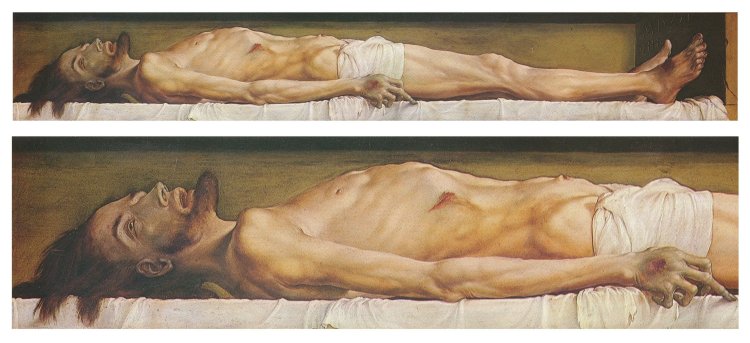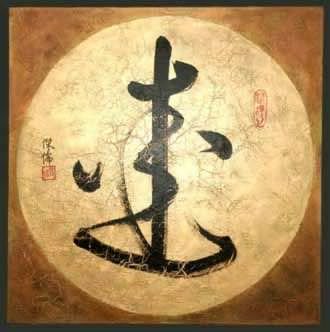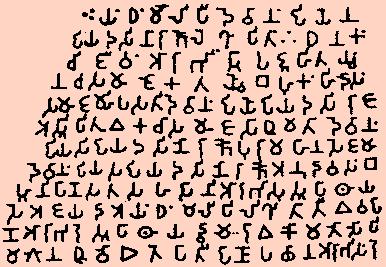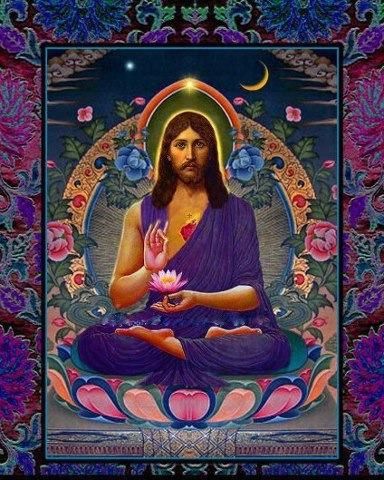Fyodor Dostoyevsky, in his novel, “The Idiot”, makes use of a painting, “The Body of the Dead Christ in the Tomb” by Hans Holbein the Younger, to bring home a point that I think, many people don’t appreciate or don’t understand to full extent.
Many see resurrection of Jesus Christ as the pivot around which the edifice of Christianity is built. Its in this conquest of Death, people think, that faithful find the proof of the trueness of the Christian doctrine. In common understanding , its thought that this very fact that Christ came back from the dead, is the central point of faith for Christians. The point from which all faith originates. And hence if this is indeed true, then the imagery of the dead body of the Christ, his battered and extremely disfigured body, his swollen and pale joints (Its reported that the model for this image was a dead body of a drowned man), as seen in “The Body of the Dead Christ in the Tomb”, should break the faith of even the most faithful, and turn them into nihilists. Because indeed, the image is very depressing and very grim. To know that Christ’s body was subject to the rules of nature as any other human body and the torture of that body was so extreme that any hope of rejuvenation of it, might seem wishful thinking at best and juvenile fantasy at worst. This seems as good enough a tool to destroy the faith inside people.

But, I think, this is not the central theme or intention for Dostoyevsky to use this painting. Even though the protagonist of “The Idiot”, Prince Myshkin, might’ve said something of the sorts, alluding to the destruction of one’s faith by looking at images like those, its that the understanding of his characters also evolves in the course of his novels. And so does the understanding of Myshkin in this case.
Another of the characters in the Novel, Ippolit Terentyev, also makes an observation about the painting. But before you read that, you should know that this Ippolit, as a personality, is the typical nihilist resentful, suicidal, egomaniac we find so often in Dostoyevsky novels. At one point in the story, he keeps the attention of a whole party centered on him for one whole night, building up to his planned ‘suicide’ at the end of it , but all of that turns out no more than another perverted tool for him to further his ego. At the end point, the pistol he was going to use for the act, jams as he presses the trigger. People laugh at him and he becomes a joke. He is one of those people who are desperate for others to take them seriously, but end up being a joke for others. Full of vanity and resentment, he is shown dying of consumption, but finds new hope in Myshkin, after getting in whose contact, his condition improves. But one thing that remains quite true in all of this is that he is genuinely depressed and sees no point in life and this creation and in the truest sense of the word, is a nihilist. So well, that out of the way, here is the observation that he makes about the painting:
“His body on the cross was therefore fully and entirely subject to the laws of nature. In the picture the face is terribly smashed with blows, swollen, covered with terrible, swollen, and bloodstained bruises, the eyes open and squinting; the large, open whites of the eyes have a sort of dead and glassy glint. . . .
Looking at that picture, you get the impression of nature as some enormous, implacable, and dumb beast, or, to put it more correctly, much more correctly, though it may seem strange, as some huge engine of the latest design, which has senselessly seized, cut to pieces, and swallowed up–impassively and unfeelingly–a great and priceless Being, a Being worth the whole of nature and all its laws, worth the entire earth, which was perhaps created solely for the coming of that Being! The picture seems to give expression to the idea of a dark, insolent, and senselessly eternal power, to which everything is subordinated, and this idea is suggested to you unconsciously. The people surrounding the dead man, none of whom is shown in the picture, must have been overwhelmed by a feeling of terrible anguish and dismay on that evening which had shattered all their hopes and almost all their beliefs at one fell blow. They must have parted in a state of the most dreadful terror, though each of them carried away within him a mighty thought which could never be wrested from him. And if, on the eve of the crucifixion, the Master could have seen what He would look like when taken from the cross, would he have mounted the cross and died as he did?”
He makes reference to ” the idea of a dark, insolent, and senselessly eternal power, to which everything is subordinated, and this idea is suggested to you unconsciously.”
Well, the face of God, as written in scriptures of many religious traditions, is not just one of compassion and kindness and tranquility. Its also something that can bring out feelings of extreme dread and fear. Its the terrible face of death itself, the face of destruction and the eternal churning of the cosmic order, the origin and disappearance of life, the sustenance and nourishment as well as the decay and utter decimation of this will to live, many a times forcefully so. Face of God is so terrible, so much so that its written in the Old Testament that, a human cannot see the face of God and live.(Exodus 33:20)

Kaal Bhairav, a form of Hindu God Shiva
In this context, the dead body of the Christ and its implication take a whole new dimension. Scientifically speaking, Christ might not have resurrected. But that should not be the determining factor in the faith of those who surrounded him. The pivot of faith, as in Christianity as in any other spiritual tradition, is Compassion. It was rather not the passion of Christ, but his compassion that must have touched the lives of his followers and given them the moral courage that manifested in them going out in the world and take his teachings to a corrupt society(of 1st century Rome) and try being good amongst those who did’nt think twice before throwing them(Christians) in front of lions in Roman Amphitheatres or burn them as night torches on crucifixes around Roman cities.
It was the compassion of the Christ that guided and drove his followers to remain or try to remain good in a corrupt world. It was compassion of Christ, compassion that he had for all of humanity, the love that he felt for his human brothers, that gave him the capability to sustain all that torture on that cross and before that. He willingly surrendered to this torture because he knew that even his murderers were part of the creation God made and the only reason they were being cruel to him was because they themselves were misguided and hence were subtly suffering. In every moment he must have felt compassion towards this suffering that the whole world was experiencing, that every living being was subject to as a given, as a persistent condition and feature of Life itself. So much was his compassion that he even asked forgiveness on behalf of his torturers and murderers. “Father, forgive them, for they do not know what they are doing.” (Luke 23:34)

Symbol of Metta (In Theravada Buddhism meditation, focus on the development of unconditional love for all beings) in Buddhist Tradition
In light of this then we see that, not the transcendence of death, but this transcendence of personal suffering in context of suffering of the whole world must have been the defining factor in the faith of those early disciple of Christ. So then, “The Body of the Dead Christ in the Tomb” should not be a depressive piece of art that should destroy our faith. In fact the very opposite should happen when we see that painting. It should give us strength, it should give us courage in face of the nihilism of the physical world. To see the dead and battered body of a being, who as Ippolit observes, was “a great and priceless Being, a Being worth the whole of nature and all its laws, worth the entire earth, which was perhaps created solely for the coming of that Being” If someone like that being can give up his life for his compassion and love and kindness he felt for all this creation, how unfortunate would be us if we question our own good intentions and our capability to act on those intentions?
Epilogue
I would like to end this article with another story from Indian Subcontinent. One of the greatest ruler of these lands was Ashoka the Great. He was one of the two kings, in the history of this region, who was successful in conquering the whole of the subcontinent under a central authority. But he was a very cruel ruler and its said that he had built a specialized building known as “Ashoka’s Hell”, with numerous chambers, to torture and kill his enemies in horrible ways. No matter if anyone wandered into this place knowingly or unknowingly, the diktat by the King was that any such person should not come out alive. The chief executioner at this place was a man named Girika , who was so vicious that he killed his own parents because they did not want him to become Ashoka’s executioner.
In Ashokavadana, the biography of Ashoka, its written that once a Buddhist Monk, Samudra wandered into this place. Girika informs Samudra that now as per the orders of the king, he would be tortured to death. Samudra accepted this and followed Girika to the torture chamber. After this point, the narrative in Ashokavadana becomes sketchy and unreliable,as it narrates as a magical story where Samudra was able to transcend all of his torture by use of magical powers he gained as part of his yogic practices. When Ashoka heard about these stories from the death chambers, he became curious and came to see all of this by his own eyes. Indeed the story turned out to be true. This had such a profound effect that Ashoka’s heart changed and he became a Buddhist.

Ashoka 1st Major Rock Edict From Girinar,in Indian state of Gujarat. Written in Brahmi script, this roughly translates to, “Formerly in the kitchen of king Devanampriya Priyadarsin many hundred thousands of animals were killed daily for the sake of curry. But now, when this rescript on morality is caused to be written, then only three animals are being killed (daily), (viz.) two peacocks (and) one deer, but even this deer not regularly. But even these three animals shall not be killed (in future).”
Even if we omit the exaggerated magical elements of the story and just think of this in this way, that even when Samudra was being tortured, he was able to transcend his personal suffering because of his Buddhist meditation practices and his understanding of the underlying reality and over and above all, because of the compassion he had in his heart for all living beings. In the most horrible situation for him personally, when his body suffered extreme forms of pain and malicious evil, he maintained his inner calm and compassion even for his torturers and to-be murderers. In this act of self sacrifice, he was so effective that he was able to turn one of the most sadistic and cruel heart of his time, that heart being the heart of Ashoka. And that act changed the course of History, much like the crucifixion and resurrection of Jesus did.
